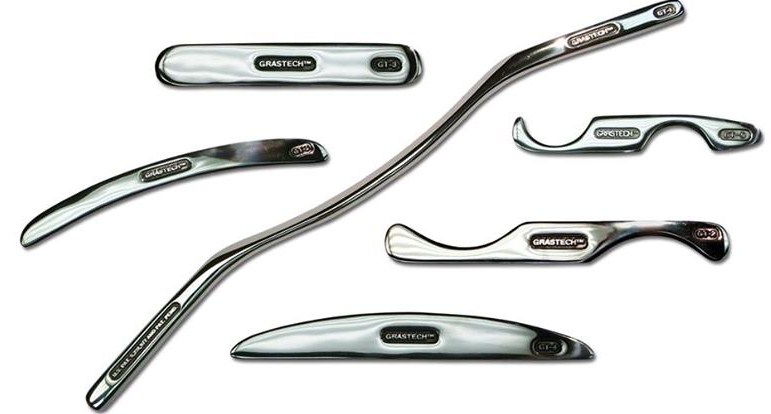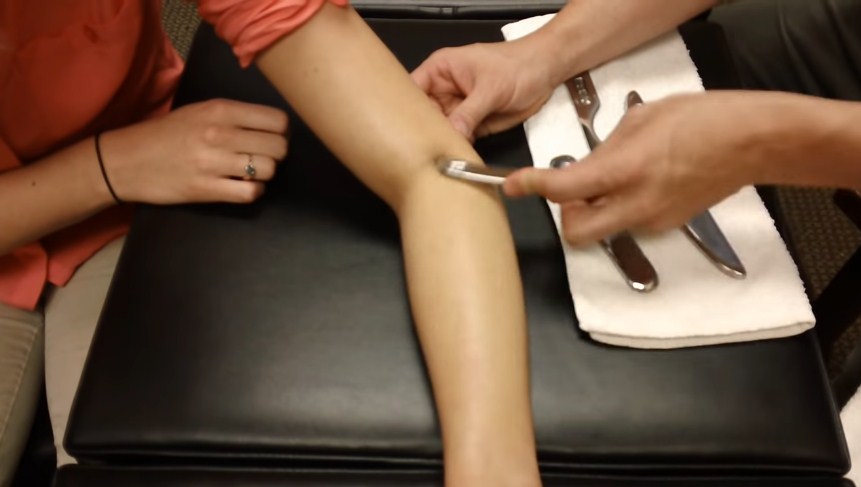The Correct and Fact Graston Method for Tennis Elbow Lateral Epicondylitis
This post will specifically explain how graston technique can relieve pain and improve function of your tennis elbow.
If you are now experiencing tennis elbow pain, you can try applying graston technique which is effective and should be one of the first-line treatments for this painful condition.

Graston technique is also handy to treat various soft tissue disorders, such as Tennis Elbow, Golfer’s Elbow and many other tendon-related conditions.
Always remember that you can combine graston technique with dry needling and stretches and corrective exercises, especially eccentric exercises for treatment of your tennis elbow which will give the best result.
When feeling tennis elbow pain, you will feel discomfort, weakness, swelling, or inflammation around the lateral epicondyle which is outside part of your elbow.
It means that the outside of your elbow or forearm towards the thumb side of your arm gets pain and you can combine graston technique with dry needling which is an excellent therapy to bring you tennis elbow pain relief.
In related to this, tennis elbow can be said as a common laymen term in which in the physical medicine world, it is called lateral epicondylitis, lateral epicondylalgia, or lateral epicondylopathy.
What is The Cause of Tennis Elbow?
Tennis elbow pain is caused by the tendons of the wrist and finger extensor muscles where the muscles lift your finger and wrist up.
As you know that, these muscles are really active in the movements
As said earlier, tennis elbow is very common to happen in that it is the result of chronic repetitive movements.
On the other words, the strain on the muscles is increased with repetition action or it is affected by an increased weight load.
In the long run, the volume of repeated action will overwhelm the muscles and tendons, leading to tendinitis.
On the other hand, some people may not conscious of what causes tennis elbow
In related to this circumstance, people who are working on front of computer often experience this kind of pain and when you are typing or using a mouse or gripping anything, for example, a barbell you can also feel tennis elbow
Moreover, for those who usually do repetitive actions such as cooking, painting, typing, weaving or knitting, lifting heavy items, carpentry, and turning a screwdriver may often experience tennis elbow
Of course, those activities may surprise you because they can cause elbow pain, since they all involve repetitive motions of the wrist and elbow.
In a simple word, the repetitive actions or activities will lead to the injury where the affected area will undergo several cycles of injury and aggravations, producing a very tender, swollen and painful elbow.
It can also be said that repetitive movements can cause excess strain on the tendon of the muscles which will lead to repetitive microtrauma to the tissues.
If it happens for a long period, these muscles are never able to heal correctly and they will continue to be traumatized over and over
Furthermore, tennis elbow or is also known as Lateral Epicondylitis is an elbow injury resulting from isolated trauma or excessive exertion of forearm muscles.
Here, the tendons attaching to the lateral epicondyle, a part of the humerus the outer part of the elbow is stressed, in which this condition can trigger elbow pain radiating toward the wrist.
Common Symptoms of Tennis Elbow
Lateral Epicondylitis itself can be said as a common condition among tennis players, weightlifters, or people involved in repetitive action that include arm and hand work.
Everytime you feel sharp pain when shaking your hands, turning a doorknob, or lifting a gallon of milk, you may be experiencing tennis elbow.
Again, tennis elbow can be said as elbow pain, in which the term itself is often associated with achiness in the arms
In accordance with this, the other symptoms of tennis elbow are as follows:
- You will feel pain on the outer area of the elbow which may extend up or down the arms
- You usually feel discomfort with wrist movements and when extending the forearm
- You will feel pain when squeezing objects or firmly grasping or holding objects
Such pain you are usually experiencing will then lead to tightness and stiffness in the forearms.
If it lasts a long time, it will lead to dull pain and muscle tightness.
The Benefit of Graston Technique for Tennis Elbow
Generally, graston technique or GT can be categorized into a soft tissue treatment functioning to speed up healing for tennis elbow in specific.

According to this, graston technique is a form of manual therapy that is also known as Instrument-assisted soft tissue mobilization or IASTM.
Instrument Assisted Soft Tissue Mobilization or IASTM are effectively used to detect and treat soft tissue fibrosis or chronic inflammation.
And, with the help of IASTM, you can scan over and detect areas of fibrotic tissue.
Related to IASTM itself, there are six different graston tools which are helpful to help break up fascial restrictions or scar tissue that develops after trauma to muscles, ligaments, tendons, or fascia, in which it is commonly referred to as soft tissue.
Meanwhile, scar tissue comes up when tissue does not heal correctly, or the tissue is under chronic, repetitive stress.
This scar tissue is weaker than normal muscle and connective tissue
Because of this, scar tissue becomes chronically sore with activity.
Graston technique treatment for tennis elbow usually uses some special designed treatment tools to glide along the skin near the surface of an injury.
In the process of the treatment, it is typically painless and comfortable
When treating tennis elbow, you may use the graston technique over the outside part of your elbow and the back of your forearm.
In accordance with this, using graston technique as tennis elbow treatment provides some benefits which include the following statements:
- Graston technique treatment increases local blood flow to local tissues which are being treated.
- Graston technique treatment increases cellular activity in the region, which includes fibroblasts, cells build tendons and connective tissue.
- Graston technique treatment inhibits muscle guarding in the affected areas resulting in less pain.
- Graston technique treatment helps to break down collagen cross-links which can be in areas where healing is poor and disorganized.
- In general, graston technique treatment helps to reduce pain, improves function, and helps you heal faster.
From such explanations, you can apply graston technique treatment for your tennis elbow because the damaged tendons lay close to the surface of the skin and are easily accessible using graston tools.
When treating tennis elbow, you must focus on the tendonous area of the extensor muscles that is located on the outer and back region of the forearm near the elbow and it affects the tendons of the extensor muscles and stimulates them to build healthy connective tissue to accommodate necessary loads.
In the meantime, you can practice graston treatment on the muscle belly regions as well since they are more towards the back of the forearm.
Practicing on that area really helps to create more tissue pliability, stretch the connective tissue, and stretch muscle fibers.
Side Effect Graston Technique as Tennis Elbow Treatment
In a glance, scraping your skin with graston tool will make red marks called red bruises
But, you can minimize the effect of scraping with graston tool by performing a light enough touch with the instruments, which are not necessarily painful.
Additionally, when graston tools are applied with even moderate pressure, it can deliver fast results
However, you may experience the possible effects when applying graston tools as tennis elbow treatment
- Light bruising seems to be fairly common and it will only happen a few days
- Mild or short-term redness often arises caused by the inflammatory histamine response
- Petechiae is also common which is caused by a form of tiny blood vessel breakage similar to bruising
- Massive bruising is rare especially for those who have sensitive skin
Related to this, the mildest bruising may be a sign of tissue damage where bruising involves the rupture of capillaries, the tiniest blood vessels.
Conclusion
Basically, applying graston technique with the right move will increase in fibroblastic activity, improved collagen production and alignment, angiogenesis, mobilization of mesenchymal stem cells into circulation, as well as changes in neurophysiology.
Or, it can be said that remodeling scar tissue will be more accurate to describe the benefit of performing graston technique.
Still related to graston technique as tennis elbow treatment, the use of IASTM combined with stretching and strengthening protocols when treating tendinopathies such as lateral epicondylitis will affect the result
For you to know is that gua sha and modern-day IASTM such as graston technique are very different.
Gua Sha here is used to target the skin and the capillaries with the intention of affecting blood stasis
And, graston technique is used to target underlying muscles, tendons, ligaments, and fascia.
Talking about petechiae or red bruises and subsequent bruising it is the effect of Gua Sha
Meanwhile, applying graston technique correctly will create red bruises.
Most graston instruments are designed to amplify tissue texture, which functions to identify abnormalities in the tissue correctly.
Once again, graston instruments are used to amplify what you can feel in your hands where you will feel the effect during the treatment with graston technique.
In order not to create red bruises when performing graston technique, you must use appropriate pressure to muscle area in pain condition.
To get the best result, you can combine graston technique with dry needling or acupuncture when treating tennis elbow condition